TFLearn 手册
http://tflearn.org
一、 各个层
(一) Core
1. Input_data:输入数据
tflearn.layers.core.input_data (shape=None, placeholder=None, dtype=tf.float32,
data_preprocessing=None, data_augmentation=None, name='InputData')
用于往网络中输入数据。其输入是一系列 shape,去创建一个新的
placeholder,或者使用一个已经存在的 placeholder。输出是拥有给定
shape 的 Placeholder Tensor。
参数意义:
shape:list of int。表示输入数据形状的 array 或者 tuple。当不提供
placeholder 的时候需要输入 shape。Shape 的第一个元素应该是 None
(表示 batch size),如果没有提供的话,会自动添加。
placeholder:用来填充这一层(可选)。
dtype:tf.type, placeholder 数据的类型(可选),默认是 float32.
data_preprocessing:A DataPreprocessing subclass object to manage
real-time data pre-processing when training and predicting (such as zero
center data, std normalization...).
data_augmentation:
DataAugmentation. A DataAugmentation
subclass object to manage real-time data augmentation while training
( such as random image crop, random image flip, random sequence
reverse...).
�
name: str。给这一层起一个名字。
2. Fully_connected 全连接层
tflearn.layers.core.fully_connected
activation='linear',
bias=True, weights_init='truncated_normal', bias_init='zeros', regularizer=None,
weight_decay=0.001,
trainable=True, restore=True, reuse=False, scope=None,
name='FullyConnected')
(incoming,
n_units,
输入:2D Tensor [samples, input dim]. 如果不是 2D 的话,输入应该
降维处理。
输出:张量[samples, n_units]
参数:
Incoming:输入的张量
N_units:这一层的单元数,int 型
Activation:激活函数的名称或者激活函数。默认是线性激活函数
Bias:bool 类型,如果是 true 则用偏置
Weights_init:初始化权值,str(name) or tensor,默认是 truncated_normal
Bias_init:初始化偏置,str or tensor。默认是‘zeros’
Regularizer:str or tensor。此层的权值上添加一个正则化矩阵,默认
是 none
Weight_decay:float。权值衰减参数,默认 0.001
Trainable:bool。如果为 true,则权值被训练
Restore:bool,如果为真,加载模型时该层的权值会被复原
Reuse:bool,如果 true 而且提供 scope,该层的变量会被重复利用(共
享)
Scope:str。定义此层的范围。这个范围可用于在层间共享变量。注
�
意这个范围会重写名字。(可选)
Name: 此层的名字,(可选)。默认“FullyConnected”。
属性:
scope: Scope.
W:tensor。用变量代表权重
b:tensor. 变量代表偏置
3. Dropout 按输入的 1 / keep_prob 的比例输出,防止模型过拟合
tflearn.layers.core.dropout
noise_shape=None,
name='Dropout')
keep_prob,
(incoming,
参数
incoming : 输入张量
keep_prob : 代表每个元素被保留的概率,float 型
noise_shape : int 型一维张量,代表随机生成的 keep/drop 标记的 shape
name : A name for this layer (optional).
4. Custom layer 自定义层
tflearn.layers.core.custom_layer (incoming, custom_fn, **kwargs)
自定义层可以对输入张量或者张量列表做任何操作,自定义函数可以
连同他自己的参数一样,被当作参数
参数
incoming : A Tensor or list of Tensor. Incoming tensor.
custom_fn : A custom function, to apply some ops on incoming tensor.
**kwargs: Some custom parameters that custom function might need.
5. Reshape
tflearn.layers.core.reshape (incoming, new_shape, name='Reshape')
�
把输入张量转化为想要的 shape
参数:
incoming: A Tensor. The incoming tensor.
new_shape: A list of int. The desired shape.
name: A name for this layer (optional).
6. Flatten
tflearn.layers.core.flatten (incoming, name='Flatten')
把输入张量变为一维的
Input
(2+)-D Tensor.
Output
2-D Tensor [batch, flatten_dims].
Arguments
incoming: Tensor. The incoming tensor.
7. Activation
tflearn.layers.core.activation (incoming, activation='linear', name='activation')
对传入的张量进行激活函数
参数
incoming: A Tensor. The incoming tensor.
activation: str (name) or function (returning a Tensor). 本层应用激活函
数. Default: 'linear'.
8. Single unit
tflearn.layers.core.single_unit
trainable=True, restore=True, reuse=False, scope=None, name='Linear')
activation='linear',
(incoming,
bias=True,
�
单层(线性层)
Input
1-D Tensor [samples]. If not 2D, input will be flatten.
Output
1-D Tensor [samples].
参数
incoming: Tensor. Incoming Tensor.
activation: str (name) or function. Activation applied to this layer (see
tflearn.activations). Default: 'linear'.
bias: bool. If True, a bias is used.
trainable: bool. If True, weights will be trainable.
restore: bool. If True, this layer weights will be restored when loading a
model.
reuse: bool. If True and 'scope' is provided, this layer variables will be
reused (shared).
scope: str. Define this layer scope (optional). A scope can be used to
share variables between layers. Note that scope will override name.
name: A name for this layer (optional). Default: 'Linear'.
属性
W: Tensor. Variable representing weight.
b: Tensor. Variable representing bias.
9. Fully connected highway
�
(incoming,
n_units,
activation='linear',
tflearn.layers.core.highway
transform_dropout=None,
bias_init='zeros',
regularizer=None, weight_decay=0.001, trainable=True, restore=True, reuse=False,
scope=None, name='FullyConnectedHighway')
Input
weights_init='truncated_normal',
(2+)-D Tensor [samples, input dim]. If not 2D, input will be flatten.
Output
2D Tensor [samples, n_units].
参数
incoming: Tensor. Incoming (2+)D Tensor.
n_units: int, number of units for this layer.
activation: str (name) or function (returning a Tensor). Activation applied
to this layer (see tflearn.activations). Default: 'linear'.
transform_dropout: float: Keep probability on the highway transform
gate.
weights_init:
str
(name) or Tensor. Weights
initialization.
(see
tflearn.initializations) Default: 'truncated_normal'.
bias_init:
str
(name)
or
Tensor.
Bias
initialization.
(see
tflearn.initializations) Default: 'zeros'.
regularizer: str (name) or Tensor. Add a regularizer to this layer weights
(see tflearn.regularizers). Default: None.
weight_decay: float. Regularizer decay parameter. Default: 0.001.
trainable: bool. If True, weights will be trainable.
restore: bool. If True, this layer weights will be restored when loading a
�
model
reuse: bool. If True and 'scope' is provided, this layer variables will be
reused (shared).
scope: str. Define this layer scope (optional). A scope can be used to
share variables between layers. Note that scope will override name.
name:
A
name
for
this
layer
(optional).
Default:
'FullyConnectedHighway'.
属性
scope: Scope. This layer scope.
W: Tensor. Variable representing units weights.
W_t: Tensor. Variable representing units weights for transform gate.
b: Tensor. Variable representing biases.
b_t: Tensor. Variable representing biases for transform gate.
10.One hot encoding
tflearn.layers.core.one_hot_encoding (target, n_classes, on_value=1.0, off_value=0.0,
name='OneHotEncoding')
将数字标签转换为二进制向量
Input
The Labels Placeholder.
Output
2-D Tensor, The encoded labels.
参数
target: Placeholder. The labels placeholder.
�
n_classes: int. Total number of classes.
on_value: scalar(标量,数量). A scalar defining the on-value.
off_value: scalar. A scalar defining the off-value.
name: A name for this layer (optional). Default: 'OneHotEncoding'.
11.Time distributed
tflearn.layers.core.time_distributed (incoming, fn, args=None, scope=None)
这一层对于输入张量的每一步都应用一个函数。这个用户自定义函数
的第一个参数应该时每一步的输入张量。用户函数的其他参数可能在
‘args’中作为一个 list 指定。
Examples
# Applying a fully_connected layer at every timestep
x = time_distributed(input_tensor, fully_connected, [64])
# Using a conv layer at every timestep with a scope
x = time_distributed(input_tensor, conv_2d, [64, 3], scope='tconv')
Input
(3+)-D Tensor [samples, timestep, input_dim].
Output
(3+)-D Tensor [samples, timestep, output_dim].
参数
incoming: Tensor. The incoming tensor.
fn: function. A function to apply at every timestep. This function first
parameter must be the input tensor per timestep. Additional parameters
may be specified in 'args' argument.
args: list. A list of parameters to use with the provided function.
scope: str. A scope to give to each timestep tensor. Useful when sharing
�

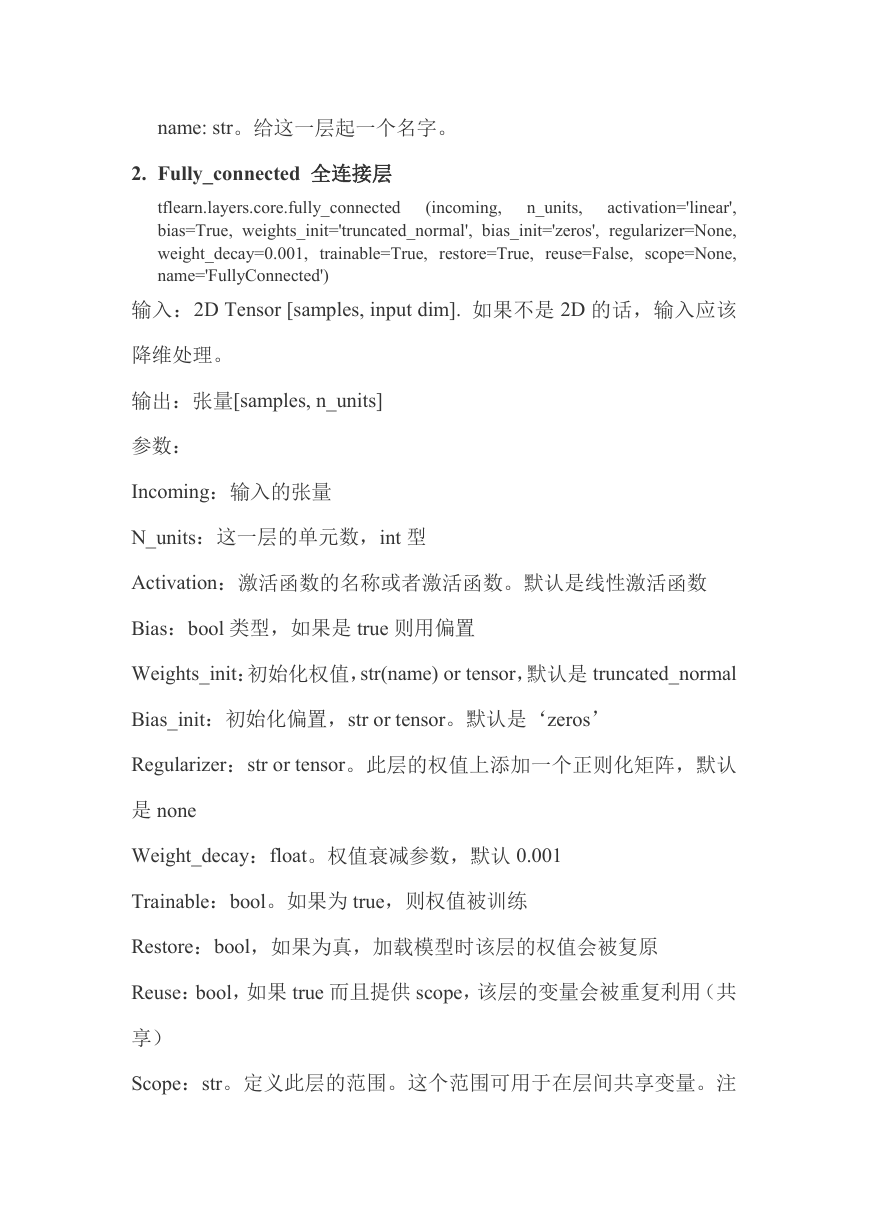

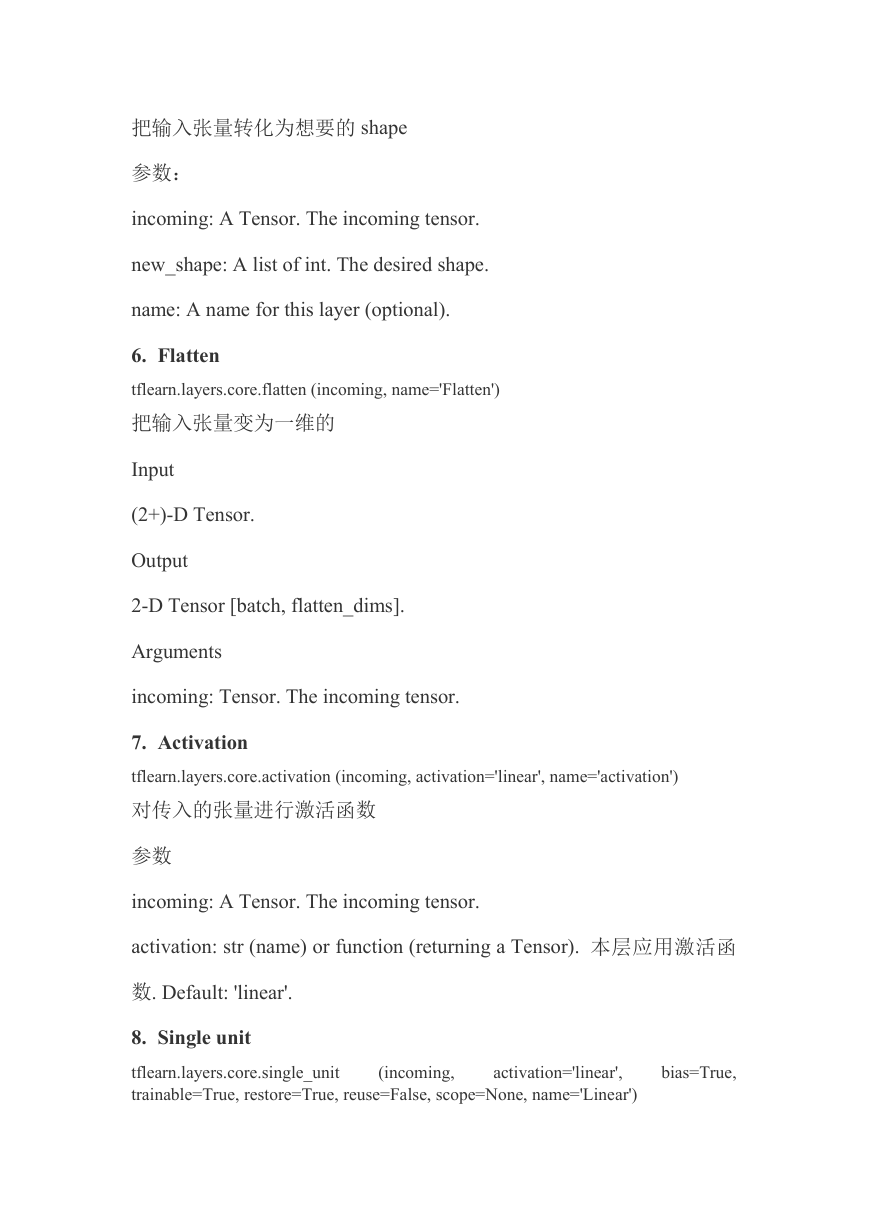
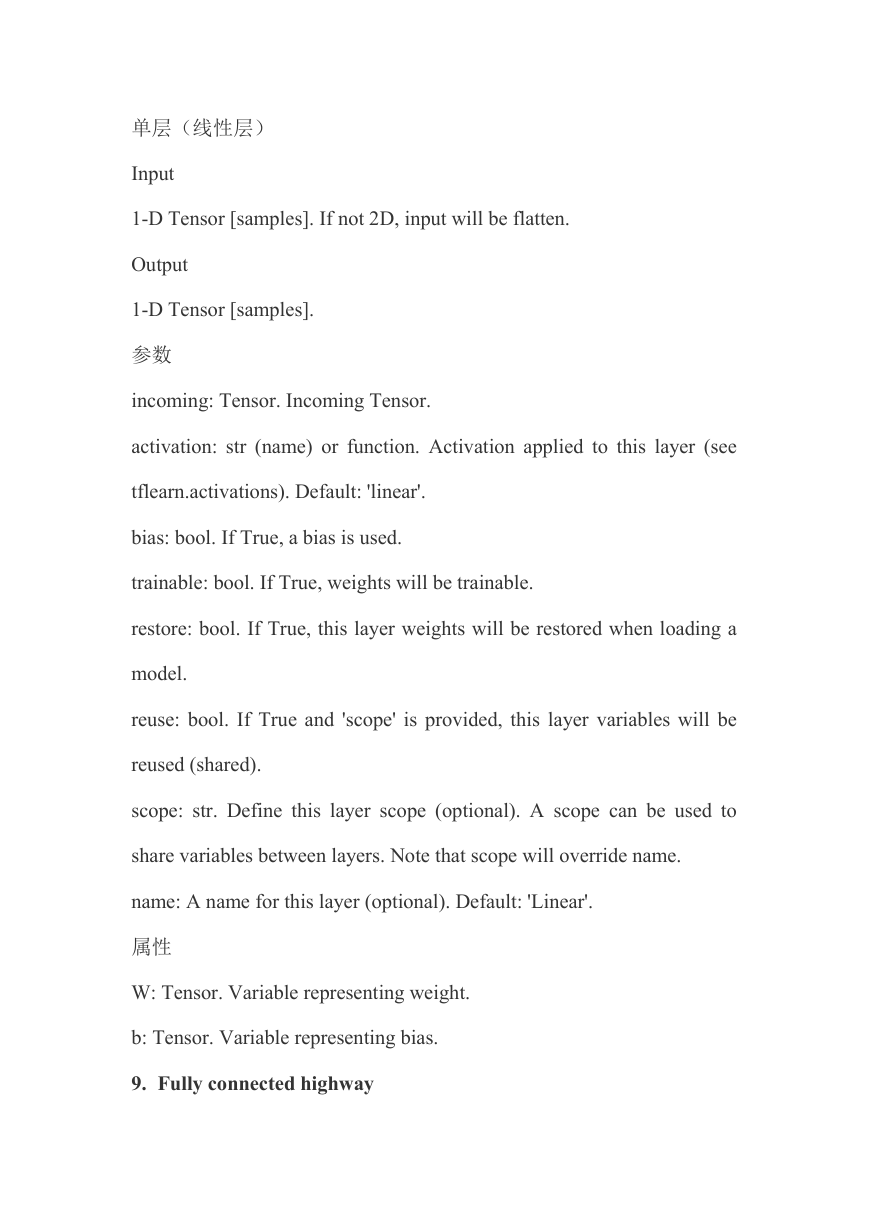
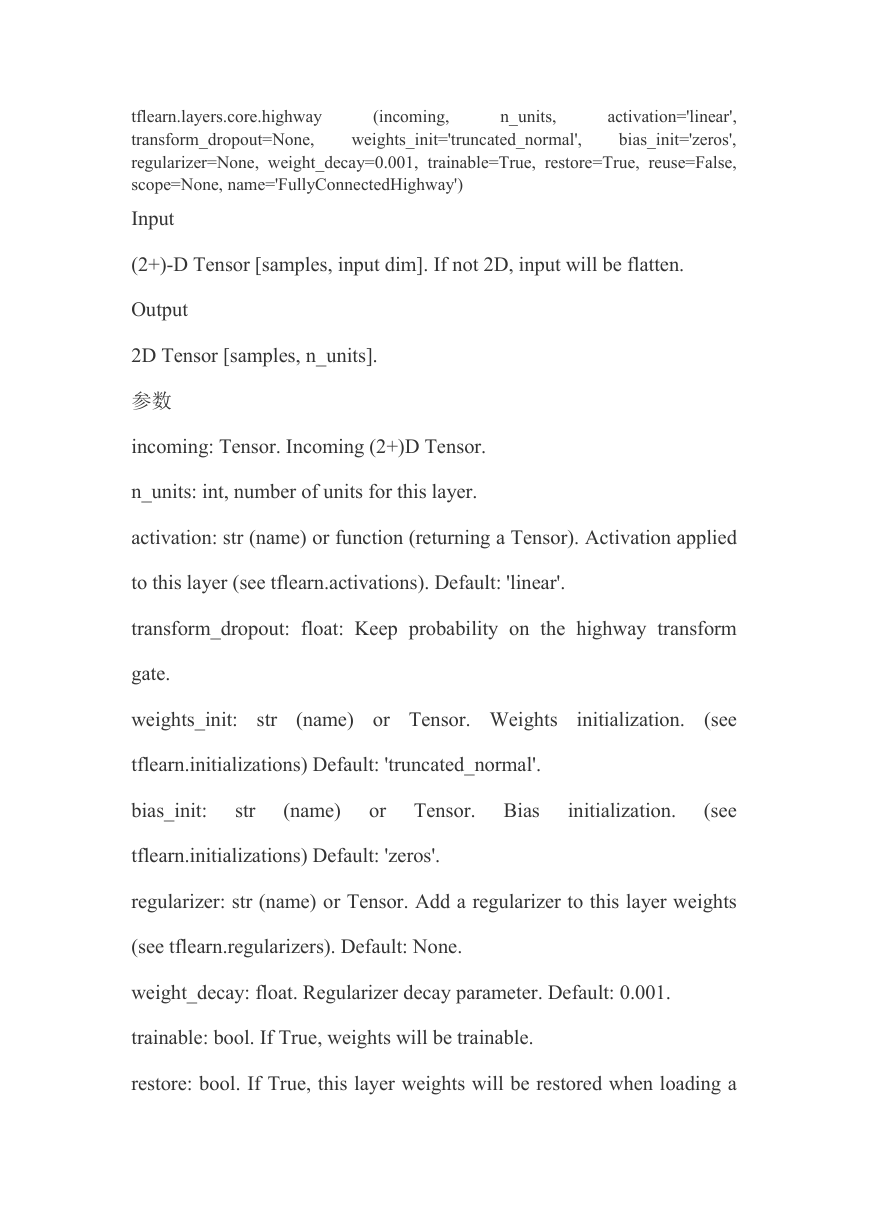
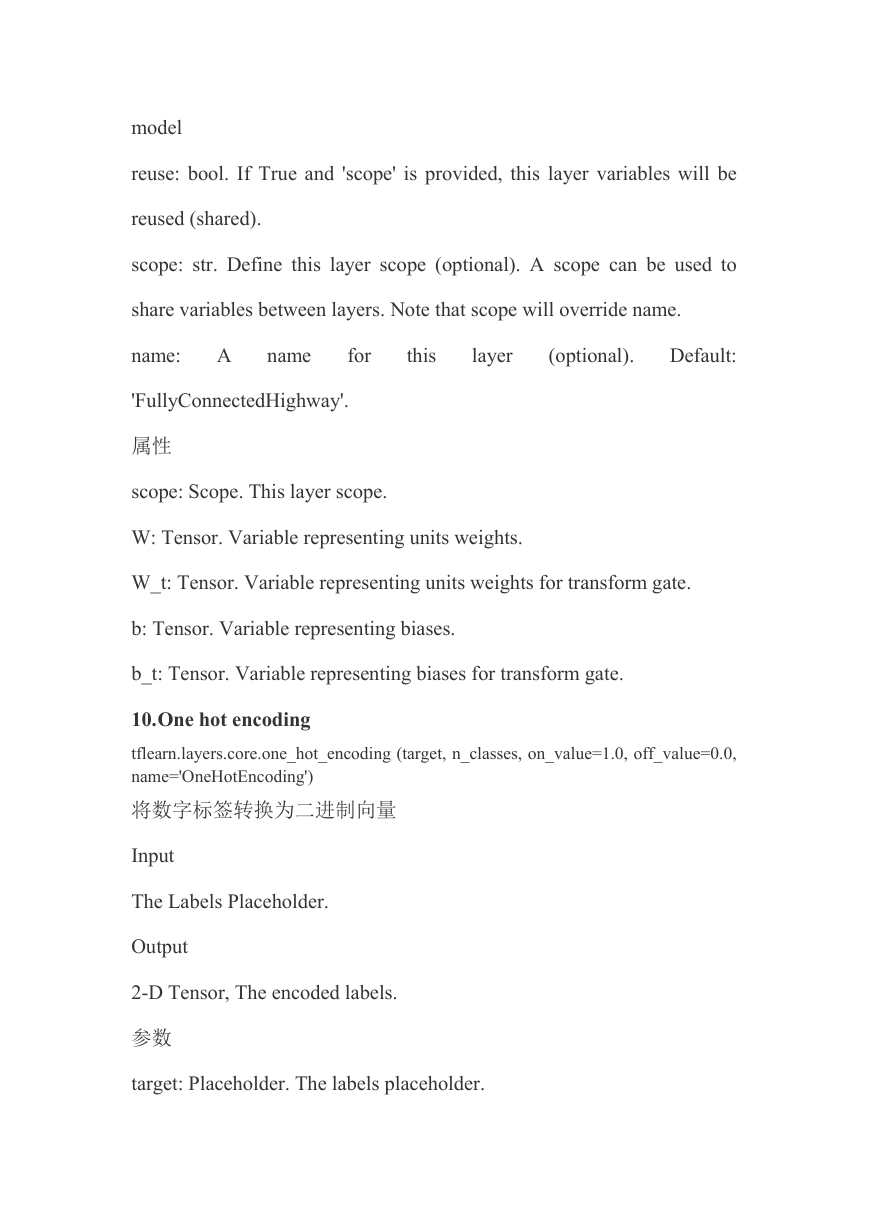
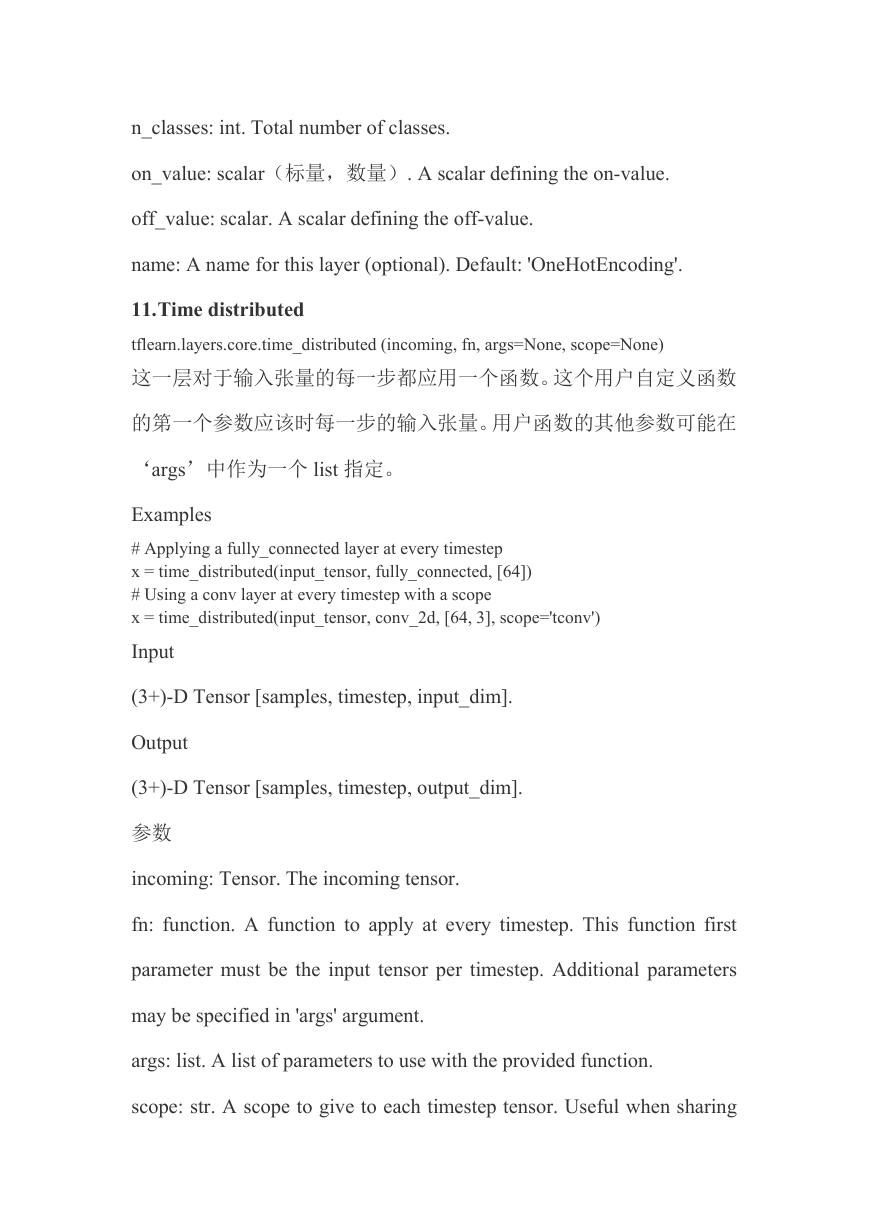








 2023年江西萍乡中考道德与法治真题及答案.doc
2023年江西萍乡中考道德与法治真题及答案.doc 2012年重庆南川中考生物真题及答案.doc
2012年重庆南川中考生物真题及答案.doc 2013年江西师范大学地理学综合及文艺理论基础考研真题.doc
2013年江西师范大学地理学综合及文艺理论基础考研真题.doc 2020年四川甘孜小升初语文真题及答案I卷.doc
2020年四川甘孜小升初语文真题及答案I卷.doc 2020年注册岩土工程师专业基础考试真题及答案.doc
2020年注册岩土工程师专业基础考试真题及答案.doc 2023-2024学年福建省厦门市九年级上学期数学月考试题及答案.doc
2023-2024学年福建省厦门市九年级上学期数学月考试题及答案.doc 2021-2022学年辽宁省沈阳市大东区九年级上学期语文期末试题及答案.doc
2021-2022学年辽宁省沈阳市大东区九年级上学期语文期末试题及答案.doc 2022-2023学年北京东城区初三第一学期物理期末试卷及答案.doc
2022-2023学年北京东城区初三第一学期物理期末试卷及答案.doc 2018上半年江西教师资格初中地理学科知识与教学能力真题及答案.doc
2018上半年江西教师资格初中地理学科知识与教学能力真题及答案.doc 2012年河北国家公务员申论考试真题及答案-省级.doc
2012年河北国家公务员申论考试真题及答案-省级.doc 2020-2021学年江苏省扬州市江都区邵樊片九年级上学期数学第一次质量检测试题及答案.doc
2020-2021学年江苏省扬州市江都区邵樊片九年级上学期数学第一次质量检测试题及答案.doc 2022下半年黑龙江教师资格证中学综合素质真题及答案.doc
2022下半年黑龙江教师资格证中学综合素质真题及答案.doc